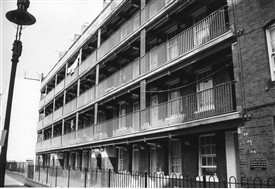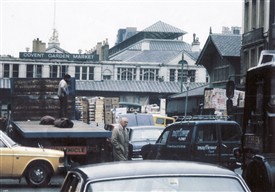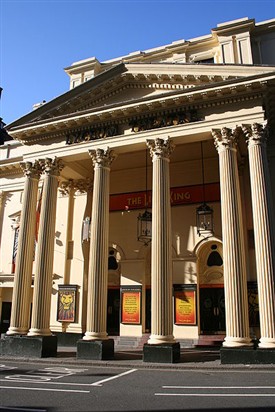"It's not what I live in, it's where I live"
The Memories of a 5th Generation Covent Garden Resident
An interview conducted by Audrey Chan

A block of apartments in Covent Garden in the 70s
Covent Garden Community Association

The market at night
Penny Saunders

The market in its last days
Penny Saunders

A space for community interaction: rollerskating at Jubilee Hall
Covent Garden Community Association

The Lyceum today
For a glimpse at the Lyceum in its days as a ballroom, see: http://www.flickr.com/photos/stagedoor/5980261115/
On a lovely May evening at the Seven Dials Club, I had the chance to meet with and interview Sarah Smith* for the Covent Garden Heritage Project. Sarah hails from a long line of Covent Garden residents, and is herself of fifth generation. ‘We’ve had a longstanding connection with the area’, she informs me from the outset – a fact that becomes quite evident when I ask more about her lineage. Originally from Italy, Sarah’s great-great-grandfather came to England in the 1880s and set up a little fruit stall in Covent Garden, where the Connaught Rooms now stand. In 1908, her grandmother was born in Drury Lane, and moved from Holborn after the war to a flat in the Peabody Estate. Having married in 1955, Sarah’s parents then made their home next door to her grandmother in Peabody as well. Marriage back then, Sarah explains, didn’t mean a family would be separated. When it was her turn, her husband moved into the area – ‘same as my dad did’, she proudly says, ‘we always kept close to one another’. Starting their life together in a flat on Charing Cross Road, Sarah and her husband slowly eased back towards Covent Garden, initially moving to Russell Street, before finally settling down in Odham’s Walk, where her grandmother and parents had all moved to by then. Speaking of her affinity with the neighbourhood, in which she currently still resides, Sarah readily professes: ‘the area is my heritage’.
Growing up in Covent Garden created a wealth of memories for Sarah that lends its geography and landmarks a distinctly personal flavour. With her extended family living all around the area, Sarah remembers: ‘we were always going to see someone in Bedford Street or Peabody’. As a child, she remembers playing in the yard with her neighbours and going on walks down Fleet Street, up to Trafalgar Square, or over to the market. Holborn and its surroundings, she adds, ‘was like a ghost town on weekends … so we were safe’. When adolescence brought her into night-time social life, Sarah informs me that the Lyceum (then a dance hall) was very much the place all the local youths would frequent. ‘Every night, you could just walk – you’d just walk! You’d just walk down there’, she fondly recalls. Integral to this experience was the looming presence of the market. Of a typical Monday or Thursday night out, Sarah describes how the walk to the Lyceum would be ‘really quiet’, but when coming out in the wee hours of the morning, one would be greeted by the ‘buzzing’ atmosphere of the market as the men went about setting up for the day’s business. ‘You’d hear as you were going by – ‘alright, gals?’, she recollects. When the market moved in 1974, the stark difference was thus ‘absolutely numbing’, Sarah recounts, where the environment was left ‘absolutely desolate’.
The moving of the market to Nine Elms was part of a larger redevelopment scheme the Greater London Council (GLC) had planned for Covent Garden. Significantly for Sarah, the plans regarding housing were carried out in a way that benefitted her family. In the old Peabody flat she had grown up in, there was neither running water, nor a toilet. A group of flats would share the use of a communal toilet and a washhouse. When the flats were modernised, Sarah remembers how her mother’s new home was equipped with a bath and a toilet. ‘It was fantastic!’, she recalls. ‘We were very lucky’, she quickly adds, unlike some other people who had inevitably been relocated out of the area completely in the process. When I ask more about how she feels about the redevelopment in retrospect, Sarah instantly brings up the Covent Garden Community Association (CGCA). Without the dedicated campaign work carried out by its members, she says: ‘we wouldn’t even have got half of what we’ve got’, darkly aware that ‘it could have been an awful lot worse had the developers got their way’. In preventing the transformation of Covent Garden into ‘a concrete jungle’, she sincerely commends them for ‘really breaking the mould’, and describes how ‘they were breaking new territory’ as their actions ‘really set the way for probably a lot of other things’. ‘They’ve done a fantastic job’, she concludes.
Sarah is adamant, however, about the irrevocable loss of community as a result of redevelopment. Citing the significant lack of social housing in the newly redeveloped Covent Garden, she expresses how it’s sad to be deprived of ‘the community we used to have’. Lamenting the fact that many locals move out as they grow old, Sarah reminds me that ‘people now live longer, and sometimes need more care as they get older’. Whereas ‘family could look after family’ in the past, as Sarah says, the distances between the homes of parents and their children now make it nearly impossible to not rely on social services. In this way, older people incapable of looking after themselves are forced to move out and leave the area simply because there are no care homes in the vicinity – ‘and that’s really sad’, she notes regretfully. When I ask what she would love to see in Covent Garden today, Sarah pauses ever so slightly before thoughtfully replying: ‘I would like to see a community hall’. Just ‘somewhere old people could go, and somewhere that the youngsters – the kids – could go’, she goes on to say. Elaborating on how her childhood was blessed with spaces for boys to play football and girls to do ballet and dancing, Sarah points out: ‘there really isn’t anything there anymore’ for the younger generation, and rightly insists ‘it would be really good to have somewhere for the children to go, somewhere fun, to let off steam’. As for the elderly folk, she earnestly hopes to see a place for them to have lunch or ‘just a cup of tea’ or to chat or even play bingo. ‘Perhaps when I get older, in another 20 years’ time, there’ll be nothing left there for me’, she frets, musing: ‘it’s just nice to try for a bit more of community spirit’.
As our session draws to a close, I ask Sarah what it feels like to live in Covent Garden today. ‘People don’t realise that there’s people still living here’, is her immediate rejoinder. Living in Central London to her, after all, is ‘all about a balance’. She rationalises: ‘you do need people who live in social housing here, you do need people who’ve got musical places to go, or penthouses, but you need that balance wherever you go’. For Sarah, this is ultimately founded on the strength of her familial ties with the neighbourhood. The spaces of Covent Garden today, as she sees them, are as much tinted with her personal associations, as they were in the 70s. Mention St. Clement Danes on the Strand and she instinctively recalls her wedding that took place there. Bring up St. Paul’s church by the Piazza and she promptly relates how her grandson was christened there. Gesturing around the room we’re seated in at the Seven Dials Club, Sarah delights in recounting how the party after her grandson’s christening was held here, as was his first birthday. As she asserts of Covent Garden: ‘It’s where I come from, it’s where I was raised. It always reminds me of my family, ‘cause that’s where my family comes from. This is my home, you know, it’s not what I live in, it’s where I live. It’s the familiarity of this area that makes it special to me’. Having listened to Sarah’s captivating memories of Covent Garden, I believe my subsequent experiences in the area will be enhanced by the knowledge of her personal encounters, and I hope that by recording her history, others will find their engagements similarly enriched as well.
*Not her real name
This interview was conducted as part of the Lottery Heritage Fund project, 'Gentlemen We've Had Enough: the Story of the Battle to Save Covent Garden'. On 10th May 2013 King's College London students, supported by Westminster Archives, the Covent Garden Community Association, and the Centre for Life-Writing Research at King's College London, interviewed Covent Garden residents about their memories of the area. Students' accounts of their interviews have been added to this Covent Garden Memories website. For more information please see:
http://www.kcl.ac.uk/artshums/ahri/centres/lifewriting/gentlemen.aspx.'